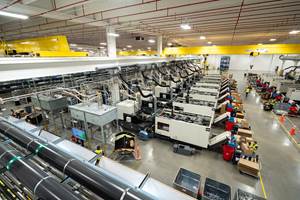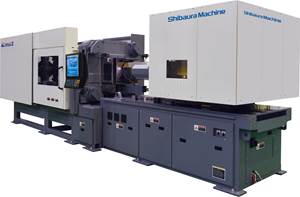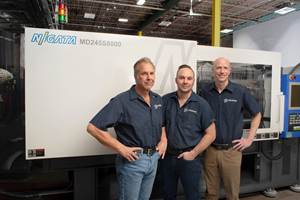How to Make the Transition to Electric Presses
Electric injection machines are becoming more and more prevalent, and as they hit the shop floor, you are responsible for making them produce parts with dimensions, appearance, and performance to client specifications.
Electric injection machines are becoming more and more prevalent, and as they hit the shop floor, you are responsible for making them produce parts with dimensions, appearance, and performance to client specifications. Like many people, you may be more comfortable with hydraulic machines, so the transition to a new kind of machine can be intimidating, frustrating, and—if a new validation is required—fairly time consuming. How you get this done correctly with a minimum of time and cost?
First, thoroughly document the process being used on the hydraulic machine. No problem, right? One of my Top 10 pet peeves is that there is no standard setup sheet for molding shops; each of the thousands of plants out there has its own kind of setup sheet. With good process information in hand, switching from a hydraulic to an electric machine is not that difficult. The clamp, cooling, hot-runner, and shot volume setpoints should be nearly identical. The only exception is injection pressures and screw positions. So, first document the hydraulic process from the point of view of the plastic. Proper documentation would include the following:
• Clamp Data:
- Minimum clamp tonnage required for the mold.
- Mold daylight requirements. Can we open it far enough to eject and get the part out? It’s not a good day when you try out a new press, the mold opens, and you don’t have enough room to remove the part you just molded. Don’t forget to include the space for the robot’s end-of-arm tooling or other special requirements.
- Ejector pattern and tie-in requirements
- Time to open mold, eject part, and close mold
- Mold dimensions. Will the mold fit into the new press without pulling the tiebars?
- Core-pull requirements. If your mold has a core pull, transferring it to an all-electric machine may be problem. Most all-electrics do not come with a hydraulic power pack, and you will need to get one or buy an electric-driven core pull and its controller. (They don’t stick out nearly as far as a hydraulic cylinder, which is nice; unfortunately, they are usually more expensive.) Hybrid (electric/hydraulic) machines should have a core-pull option.
- While not actually part of setting a mold, it should be required that the mold has documentation showing its use/maintenance/repair history, what the typical problems are, and that it is ready for production. (You could use color-coded tags for the latter.) In addition, there ought to be system to keep track of the mold’s location. It is amazing how much time and money is wasted looking for a “lost” mold or finding it in the repair shop when it is scheduled for production.
• Cooling Data:
- Coolant gpm required for turbulent flow in each water line. (Turbulent flow is characterized by a Reynolds number of 5000 or higher, as we explained in last month’s column.) And, you need a way to duplicate this from one run to another. This can be done, and it’s necessary, since 95% of your cycle is cooling.
- Temperature setting on the chiller or temperature controller for each side of the mold and any special lines, like a chilled line for living hinges.
- Cooling time. It must be longer than screw rotate or plasticating time. Cycle time should not be dependant on screw recovery. Make sure your cooling time is longer then your longest plasticating time. This will help provide consistent cycles, critical for making identical parts.
- Part temperature at 30 sec (or other fixed time) after ejection.
• Hot-Runner Setup Data, Startup Procedure:
- If you have these well documented for the hydraulic machine, there should be no need for changes for an electric press. You’ll need to know hot-runner tip temperatures, manifold temperatures, etc. and have an easy-to-read diagram of the hot-runner system. Which lines control which manifolds and which tips? Knowing that will save hours of debugging.
- Have startup instructions-or better yet, a full procedure. Nearly every hot runner and controller are a species of their own. Tip temperatures come up faster than manifold temperatures, so provide timed sequences to increase temperature uniformly throughout the hot half (after a soft start to bake out any moisture). Differential thermal expansion upon heat-up has cost the industry millions.
• Injection Unit Data (the one place where there is a difference between hydraulic and electric machines):
- Temperatures—all zones and feed throat should be PID controlled and run the feed throat warm (140 to 160 F) to allow gases to escape. Most plastic pellets will not stick together at these temperatures.
- Times—these are set the same as on your hydraulic press. These include fill time, hold time, gate-seal time, and screw-rotate or plasticating time. While the last is not a settting, but results from a combination of screw rpm and backpressure, document the average plasticating time for the hydraulic machine and adjust rpm on the electric machine to give the same result.
- A picture of the part and its weight with no hold pressure. This is usually a short shot.
- Stroke positions—the goal here is to duplicate the volume of plastic used to fill the mold. Since most machines use setpoints in linear inches or millimeters, you must convert all stroke positions to volume and back calculate to find the new machine’s stroke positions. Use this equation:
- Volume = 3.1416 × the radius (r) of the screw or barrel squared × the stroke length (L). (V = 3.1416r2L)
- Shot size.
- Decompression—i.e., cutoff or first-stage to second-stage transfer position, and cushion.
- Pressures (melt pressures not hydraulic). These include the maximum allowable first-stage injection pressure, peak pressure during the first stage (often the same as the pressure at transfer, but not always), pressure at transfer, hold pressure, backpressure, nozzle contact pressure (hard to get, but nice to know, for both hydraulic and electric machines.) For all-electric machines, all pressures are expressed as melt pressure. There is no hydraulic system pressure. If you have been dealing with hydraulic pressures on your setup sheets, you will need to convert them to melt pressure. All you need is the machine’s intensification ratio to convert hydraulic pressure to plastic (melt) pressure. Just multiply that ratio by the hydraulic pressure. Please note: Most hydraulic machines do not have an intensification ratio of 10:1, at least not machines built since the 1970s. (For guidance on how to calculate intensification ratio for any hydraulic machine, visit my website: scientificmolding.com/articles/Intensification_ratio[1].pdf.)
READY, SET UP, GO
Now that we have all the data from the perspective of the plastic, we are ready to set up the electric press:
- Check that the mold has been mounted properly and that all machine/mold safeties are working properly
- Set the temperatures as you had on the hydraulic press.
- Adjust clamp speeds, acceleration, and deceleration, so the clamp moves smoothly, without jerking, within the same time as the hydraulic process. Clamp operation should mimic the hydraulic press.
- Set mold safety. Many electrics allow you to do it for the entire clamp travel distance. If set properly, you should be able to tape a white foamed cup on a safe place on the mold and it should not crush more than 0.25 in. Learn how to do this to prevent mold damage.
- Adjust ejection speed, velocities and pressures. It is critical to use just enough pressure to move the ejectors at the speed you want. Do not use excessive pressure, because if you accidently drive the ejector plate to its stop with high pressure you can severely foul up the ejector drive on some machines. Plus, low ejection pressure will allow you to catch galling ejector pins before they break—they will not come out under low pressure.
- Set the timers the same as on the hydraulic press.
- Set injection stroke (shot size) to the calculated value.
- Set the cutoff position a bit higher than calculated just to make sure you do not over-fill the cavity on the first shot.
- Set hold pressure to 50 psi plastic pressure or the lowest the machine will allow.
- Set first-stage pressure lower than what was calculated, for the first shot only.
- Guess at an appropriate injection speed, usually relatively slow. This is only for startup; you will fine-tune this shortly.
- Make sure that this first shot can be ejected or removed from the mold, as it should be short.
- Double-check all positions, temperatures, core pulls, hot runners, resin grade, color, moisture content, and whatever else is important for a safe startup.
- Load resin, purge the machine, and then rotate the screw back to the set shot size
- Make a shot on semi automatic.
- If the shot is not short, adjust shot size or position transfer to make a short shot.
- Once you are making a short shot that can be ejected and other startup issues are working properly, go to automatic cycle and adjust the first-stage pressure to make sure the machine is under velocity control and not pressure limited. Make sure you have an adequate first-stage pressure available (an appropriate Delta P, as explained in my January column here).
- Manipulate the machine’s injection velocity and cutoff position to provide a short shot that weighs the same and looks like the picture of the short shot from the hydraulic machine at the same fill time (±0.04 sec) as the hydraulic process. Make sure you are not bottoming the screw.
- Check that the peak pressure and pressure at transfer are similar to those of the hydraulic press. Again, these are melt pressures. If they are not similar to melt pressures on the hydraulic press, find out why. It’s usually due to a wrong nozzle tip or nozzle body length.
- Once this first-stage short shot is identical to that of the hydraulic press, add second-stage pressure. Start at 500 to 1000 psi.
- Raise second-stage pressure in increments up to the hold pressure established on the hydraulic press. As you are raising second-stage pressure, watch the part for flash, sticking, or any other mold problems. If a problem develops and the part is not properly packed, check the mold temperature, parting line, actual clamp pressure, and other possible causes.
- Adjust screw rpm, not backpressure, to match the plasticating time of the hydraulic press.
- Check that your cushion is okay. If not, move both shot size and cutoff position the same distance to get the desired cushion.
- Check cycle time and adjust as necessary to match the hydraulic press.
- If parts look good at the right cycle time and the right ejection temperature, mold parts until the pressure at transfer stabilizes to an acceptable range and then take a “first part” to Quality Control for inspection.
This ought to get you identical parts. If not, let me let me know. There may be issues if you go from a fully hydraulic clamp to an electric-powered toggle, and if you have different pack velocity conditions between machines. Also, all of this assumes your machines are reading positions, pressures, and times accurately.
About the Author
John Bozzelli is the founder of Injection Molding Solutions (Scientific Molding) in Midland, Mich., a provider of training and consulting services to injection molders, including LIMS, and other specialties. E-mail john@scientificmolding.com or visit scientificmolding.com.
Related Content
IPEX Opens Injection Molding Facility in North Carolina
The pipe and fittings manufacturer’s new 200,000-square-foot facility represents a $200 million investment and will create 150 jobs.
Read MoreAbsolute Haitian Brings Next Generation of Presses to Orlando
NPE2024: Absolute Haitian says Generation 5 of the servo-hydraulic Haitian and electric Zhafir machines lines emphasize efficiency, performance and intelligence.
Read MoreCompletely Connected Molding
NPE2024: Medical, inmold labeling, core-back molding and Industry 4.0 technologies on display at Shibaura’s booth.
Read MoreCustom Injection Molder Plugs into All Electric Machines
Formerly a showroom for early-aughts-era Van Dorn hydraulics, the newest additions to Drummond Industries’ transforming fleet are all-electric Niigata injection molding machines.
Read MoreRead Next
Beyond Prototypes: 8 Ways the Plastics Industry Is Using 3D Printing
Plastics processors are finding applications for 3D printing around the plant and across the supply chain. Here are 8 examples to look for at NPE2024.
Read MoreMaking the Circular Economy a Reality
Driven by brand owner demands and new worldwide legislation, the entire supply chain is working toward the shift to circularity, with some evidence the circular economy has already begun.
Read MoreFor PLASTICS' CEO Seaholm, NPE to Shine Light on Sustainability Successes
With advocacy, communication and sustainability as three main pillars, Seaholm leads a trade association to NPE that ‘is more active today than we have ever been.’
Read More
.jpg;width=70;height=70;mode=crop)













